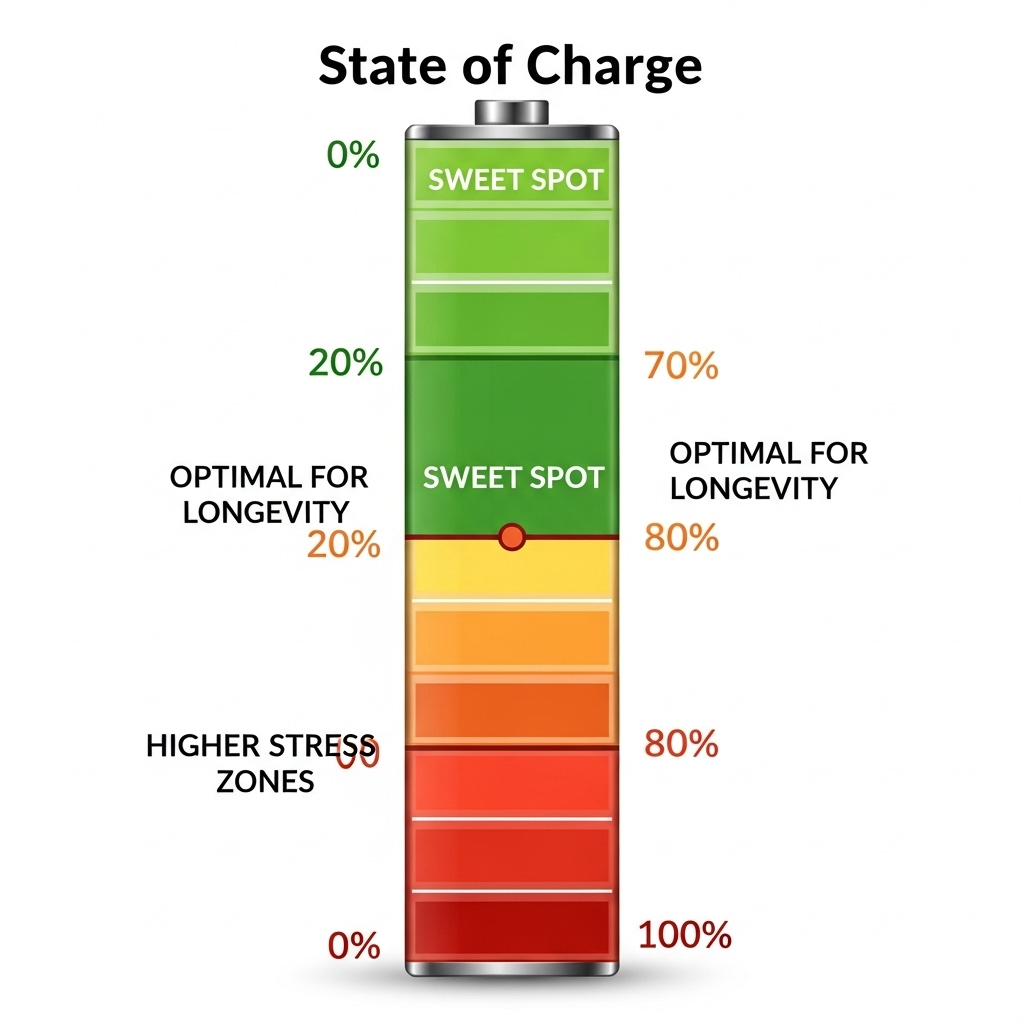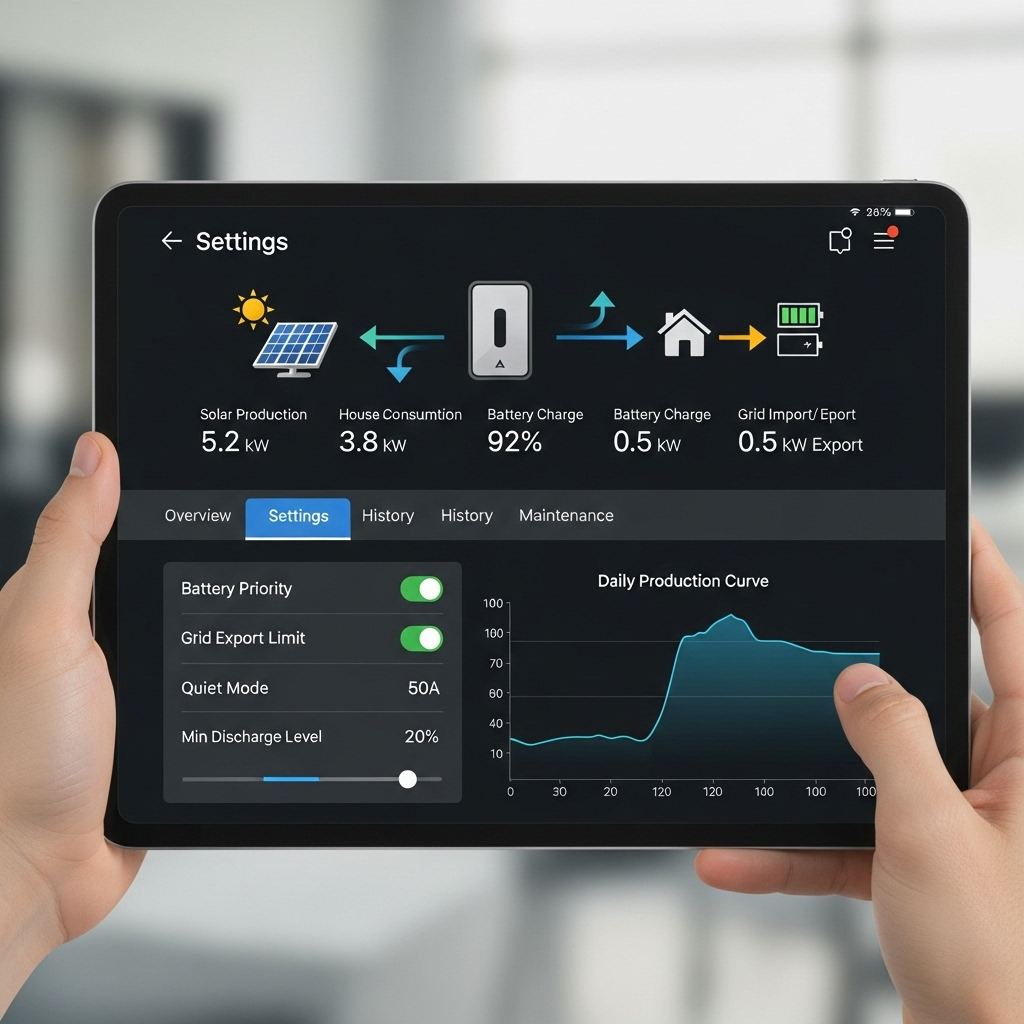Investing in a solar energy storage system is a significant step toward energy independence. To get the most out of that investment, you need to ensure your batteries last as long as possible. One of the most effective strategies for extending battery life is managing its daily State of Charge (SOC). By setting specific upper and lower limits for your battery's daily charge, you can dramatically increase its lifespan and ensure reliable performance for years to come.
This guide explains the principles behind SOC management, why it is critical for battery health, and how you can implement daily SOC windows to optimize your energy system. We will cover the fundamentals of battery longevity and provide practical steps for different usage scenarios.
Understanding the Core Principles of Battery Health
Before adjusting settings, it's helpful to understand what happens inside your battery. A battery's health is influenced by several factors, but how you charge and discharge it daily plays a leading role.
What are SOC, DoD, and Cycle Life?
Think of your battery's State of Charge (SOC) as its fuel gauge, shown as a percentage from 0% (empty) to 100% (full). The Depth of Discharge (DoD) is the opposite; it measures how much energy you have used. For example, if you discharge your battery from 100% down to 30%, its DoD is 70%.
A "cycle" is one full charge and discharge. A battery's cycle life is the number of cycles it can complete before its capacity degrades to a specific point, typically 80% of its original rating. Consistently pushing a battery to its SOC extremes (0% or 100%) puts stress on its internal components, which can shorten its cycle life. The International Renewable Energy Agency (IRENA) highlights that smoother cycling conditions directly contribute to a longer battery life.
The LiFePO4 Advantage
The chemistry of your battery is fundamental to its performance and lifespan. Lithium Iron Phosphate (LiFePO4) batteries are a leading choice for residential and commercial energy storage due to their inherent stability and longevity. At ANERN, we specialize in high-performance LiFePO4 batteries because they offer superior safety and a much longer cycle life compared to other lithium-ion chemistries. Even with this robust technology, applying smart management techniques like SOC windows unlocks its full potential.
Key Factors That Impact Battery Longevity
Several variables determine how long your battery will last. While you can't control all of them, SOC is one of the easiest to manage.
- State of Charge (SOC) Window: Keeping the battery within a moderate SOC range (e.g., 20% to 80%) reduces stress on the cells.
- C-Rate: This is the speed at which a battery is charged or discharged. Lower C-rates are gentler on the battery. You can learn more about how to Advanced Tuning: Pair C-Rates with SOC Windows to Cut Wear.
- Temperature: Extreme heat or cold can accelerate battery degradation. A climate-controlled environment is ideal.
- Deep Cycling: Regularly discharging the battery to a very low SOC is one of the fastest ways to reduce its lifespan.
Setting Strategic SOC Windows for Optimal Performance
The goal of a daily SOC window is to find a balance that meets your energy needs without over-stressing the battery. This "sweet spot" ensures you have enough power while reserving the battery's full capacity for when you truly need it.
Why Partial Charging is the Key to a Longer Life
Operating a battery in a partial state of charge is less stressful than full charge-discharge cycles. The common "20-80%" guideline is a popular starting point because it avoids the high-stress states at the top and bottom ends of the charge range. While the exact numbers can be debated, the principle is sound. For a deeper analysis, explore The 20–80% Debate: Optimal Daily SOC for Home ESS Longevity.
The relationship between Depth of Discharge and cycle life is not linear. A small reduction in daily DoD can lead to a large increase in total cycles, as shown in the table below.
| Daily Depth of Discharge (DoD) | Typical LiFePO4 Cycle Life |
|---|---|
| 100% | ~3,000 cycles |
| 80% | ~5,000 cycles |
| 60% | ~7,500 cycles |
| 40% | ~10,000+ cycles |
Note: These are illustrative figures. Actual cycle life depends on battery quality, temperature, and other factors.
How to Configure Your Daily SOC Window
Implementing a SOC window is typically done through your solar inverter's control panel or the software for your Battery Management System (BMS). ANERN's integrated home energy storage systems are designed to make this process simple, allowing you to set minimum and maximum charge levels directly. These settings tell the system when to stop charging from solar and when to stop discharging to power your home. For a detailed look at the tools involved, see this review of Tools Review: Inverter Settings That Enforce Daily SOC Windows.
Is a 100% Charge Ever Necessary?
While avoiding daily 100% charges is recommended, an occasional full charge can be beneficial. Most advanced BMSs use a full charge cycle (typically once every few weeks) to perform "cell balancing." This process ensures all individual cells within the battery pack are at an equal voltage, which is crucial for overall pack health and accurate SOC readings. The key is that this is an infrequent maintenance event, not a daily routine. You can explore this topic further in Myth vs Reality: Is 100% Daily Charge Safe for LiFePO4 Packs?.
Customizing SOC Windows for Your Application
The ideal SOC window isn't one-size-fits-all. It depends on your primary goal, whether it's maximizing savings, ensuring backup power, or simply getting the longest possible life from your system.
Balancing Longevity with Time-of-Use (ToU) Savings
If your utility has Time-of-Use rates, you can save money by using stored battery power during expensive peak hours. This may require a wider SOC window to ensure you have enough energy. A smart strategy involves programming your system to charge fully before peak hours begin and discharge down to a set minimum by the time cheaper off-peak rates start. This approach requires a careful balance, which is detailed in this Blueprint: Daily SOC Schedules Balancing ToU Savings and Life.
SOC Strategies for Emergency Backup
For systems primarily intended for backup power, the priority shifts from daily cycling to maintaining readiness. In this case, you would set a very high minimum SOC, such as 90% or 95%. The battery will remain nearly full, ready to take over during an outage. While keeping a battery at a high SOC can cause some calendar aging, it is often a necessary trade-off for security. To avoid common errors in this setup, review these 7 Costly Mistakes When Choosing Daily SOC Limits for Backup. For specific recommendations, see this Q&A: What Daily SOC Window Should I Use for Emergency Reserve?.
Adapting SOC Windows to Seasonal Changes
Temperature has a significant impact on battery health. In regions with very hot summers or cold winters, adjusting your SOC window seasonally can provide extra protection. For example, during a heatwave, you might narrow the window (e.g., 30-75%) to reduce thermal stress. In winter, you might need a wider window to compensate for reduced solar production. This proactive approach is covered in our Seasonal Strategy: Adjust SOC Charge Range for Heat and Cold.
Real-World Data and Practical Application
Theory is important, but seeing the results in practice provides confidence. Data and real-world examples show just how effective SOC management can be.
Data-Backed Guide to SOC and Cycle Life
Extensive testing across the battery industry has confirmed the direct link between SOC windows and longevity. As detailed in our comprehensive guide on solar storage performance, limiting the depth of discharge has a direct, measurable impact on the total energy throughput of a battery over its lifetime. A battery cycled daily within a 50% window can last more than twice as long as one cycled at 100%. For more data, consult this Data-Backed Guide: SOC Window vs Cycle Life in Home Batteries.
Case Study: Extending ESS Life on a Farm
A practical example can be seen in off-grid applications where reliability is critical. In one case, an off-grid farm implemented a 30-90% daily SOC window for its energy storage system. This strategy ensured enough power for daily operations while avoiding deep discharges. The result was a significant extension of the battery's expected service life, providing a more reliable and cost-effective power source. Read the full story here: Case Study: 30–90% SOC Window Extended ESS Life on a Farm.
Avoid the Deep Cycling Habit
A common misconception is that you should use your battery's full capacity every day to get your money's worth. In reality, this approach accelerates degradation and leads to an earlier replacement. By adopting smarter SOC bands and avoiding daily deep cycling, you enhance both the cycle life and the calendar life of your battery, ensuring a better long-term return on your investment. Learn how to break this habit in Stop Deep Cycling Daily: Smarter SOC Bands for Calendar Life.
Your Path to a Longer-Lasting Energy System
Effectively managing your battery's daily State of Charge is one of the most powerful tools you have for protecting your solar energy investment. By setting a conservative daily SOC window, you can dramatically extend the lifespan of your battery, improve its reliability, and ensure it delivers value for many years. This simple adjustment, easily configured in modern inverters and energy storage systems, puts you in control of your system's health.
At ANERN, we are committed to providing reliable and scalable energy solutions. Our integrated systems featuring high-quality LiFePO4 batteries are designed to give you the control needed to implement these longevity strategies, helping you achieve true energy independence with equipment built to last.
Disclaimer: The information provided in this article is for educational purposes only. It does not constitute financial or investment advice. Please consult with a qualified professional before making any decisions regarding your energy system.





Leave a comment
All comments are moderated before being published.
This site is protected by hCaptcha and the hCaptcha Privacy Policy and Terms of Service apply.